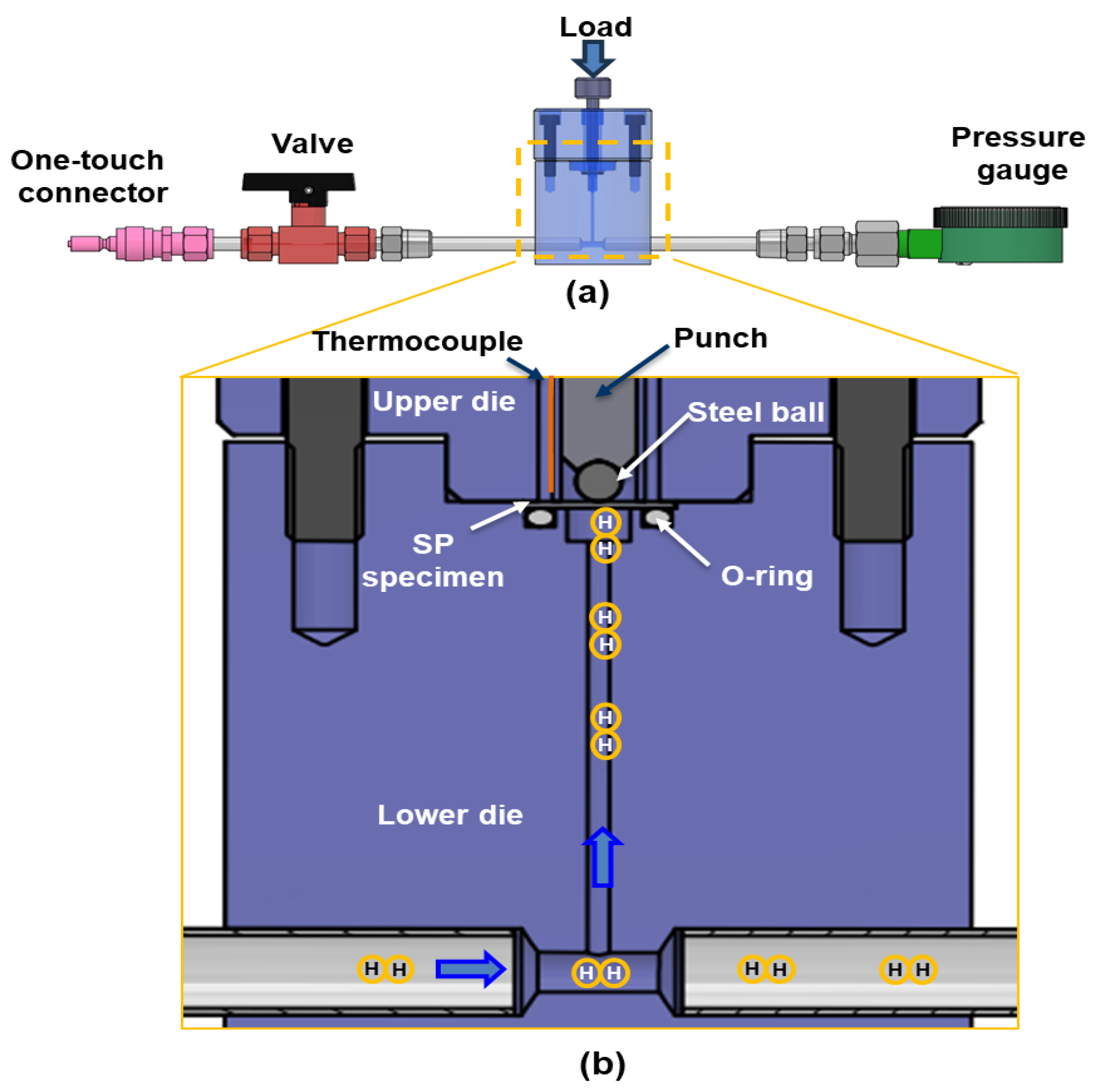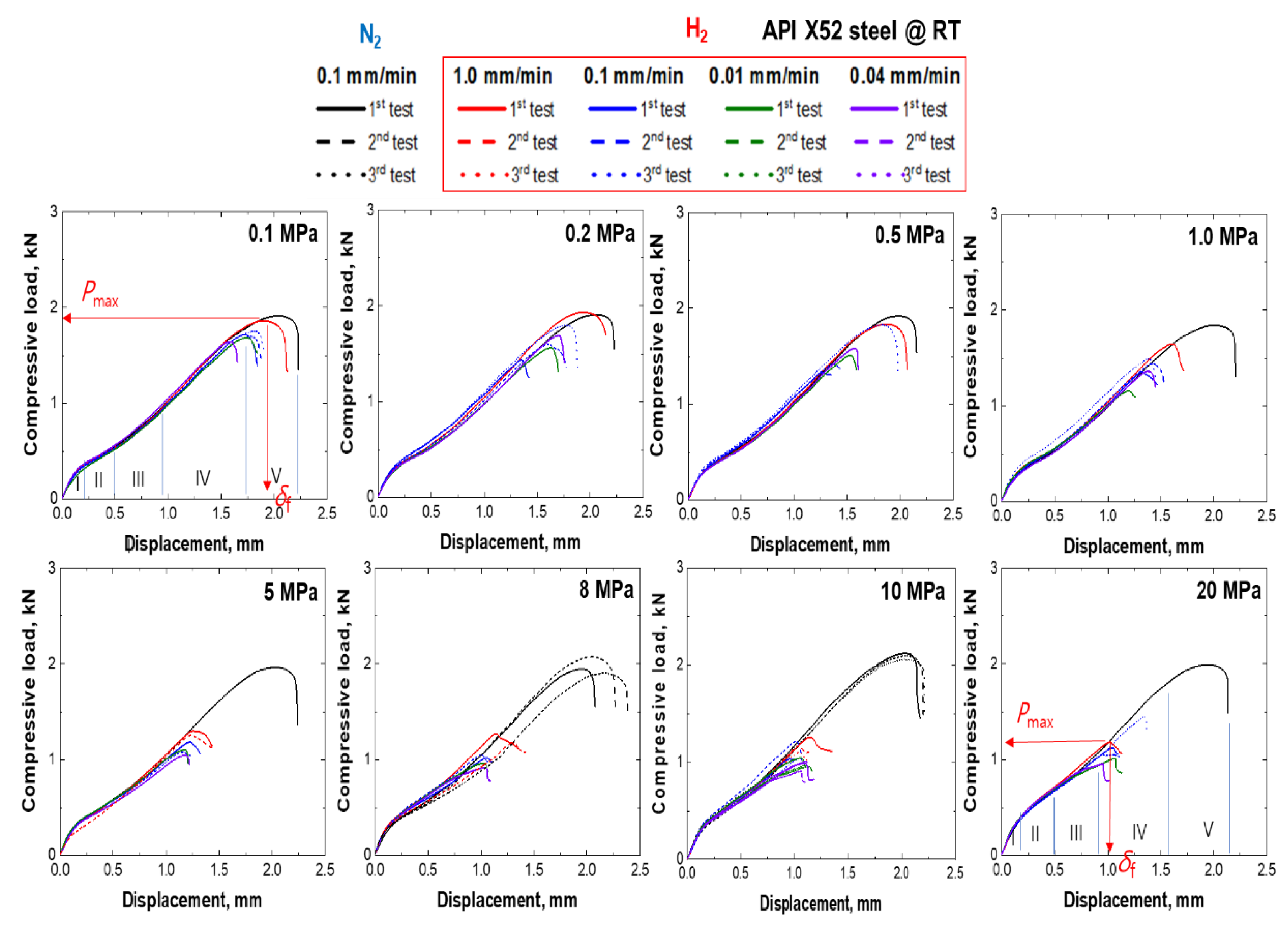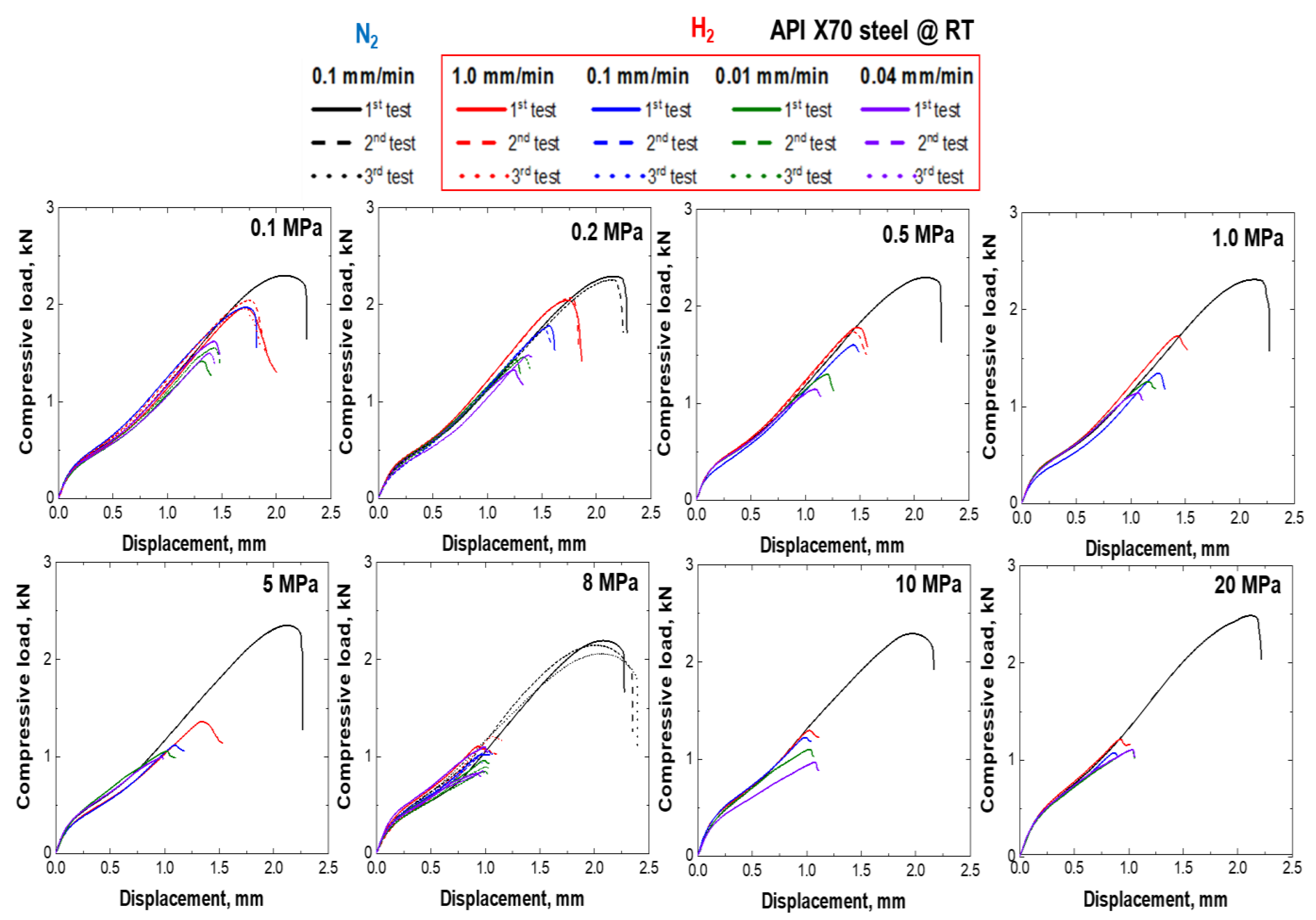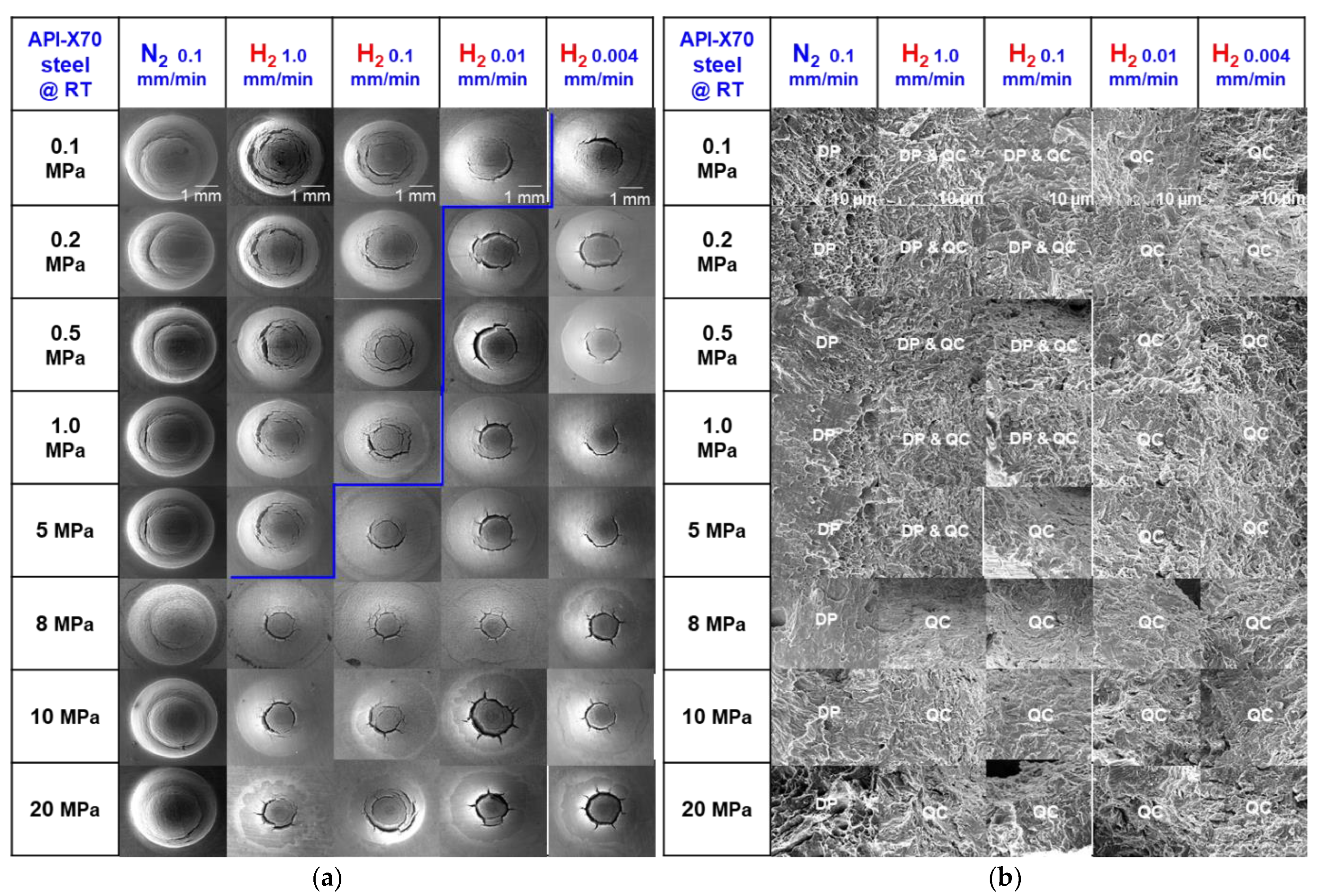Effect of Hydrogen Pressure and Punch Velocity on the Hydrogen Embrittlement Susceptibility of Pipeline Steels Using Small Punch Tests under Gaseous Hydrogen Environments at Room Temperature
Abstract
:1. Introduction
2. Experimental Procedures
2.1. Specimens
2.2. Experimental Procedure
3. Experimental Results
3.1. Hydrogen Embrittlement Behaviors for API-X52 Steels
3.2. Hydrogen Embrittlement Behaviors for API-X70 Steels
4. Discussion
5. Conclusions
Author Contributions
Funding
Data Availability Statement
Conflicts of Interest
References
- Ashari, P.A.; Oh, H.; Koch, C. Pathways to the hydrogen economy: A multidimensional analysis of the technological innovation systems of Germany and South Korea. Int. J. Hydrogen Energy 2023, in press. [Google Scholar] [CrossRef]
- Ishaq, H.; Dincer, I. A comprehensive study on using new hydrogen-natural gas and ammonia-natural gas blends for better performance. J. Nat. Gas Sci. Eng. 2020, 81, 103362. [Google Scholar] [CrossRef]
- Ronevich, J.A.; Song, E.J.; Somerday, B.P.; Marchi, C.W.S. Hydrogen-assisted fracture resistance of pipeline welds in gaseous hydrogen. Int. J. Hydrogen Energy 2021, 46, 7601–7614. [Google Scholar] [CrossRef]
- Michler, T.; Lee, Y.; Gangloff, R.R.; Naumann, J. Influence of macro segregation on hydrogen environment embrittlement of SUS 316L stainless steel. Int. J. Hydrogen Energy 2009, 34, 3201–3209. [Google Scholar] [CrossRef]
- Zheng, J.; Liu, X.; Xu, P.; Liu, P.; Zhao, Y.; Yang, J. Development of high-pressure gaseous hydrogen storage technologies. Int. J. Hydrogen Energy 2012, 37, 1048–1057. [Google Scholar] [CrossRef]
- Matsunaga, H.; Yoshikawa, M.; Kondo, R.; Yamabe, J.; Matsuoka, S. Slow strain rate tensile and fatigue properties of Cr–Mo and carbon steels in a 115 MPa hydrogen gas atmosphere. Int. J. Hydrogen Energy 2015, 40, 5739–5748. [Google Scholar] [CrossRef]
- San Marchi, C.; Michler, T.; Nibur, K.A.; Somerday, B.P. On the physical differences between tensile testing of type 304 and 316 austenitic stainless steels with internal hydrogen and in external hydrogen. Int. J. Hydrogen Energy 2010, 35, 9736–9745. [Google Scholar] [CrossRef]
- Yamabe, J.; Takakuwa, O.; Matsunaga, H.; Itoga, H.; Matsuoka, S. Hydrogen diffusivity and tensile-ductility loss of solution-treated austenitic stainless steels with external and internal hydrogen. Int. J. Hydrogen Energy 2017, 42, 13289–13299. [Google Scholar] [CrossRef]
- ASTM G142-98; Standard Test Method for Determination of Susceptibility of Metals to Embrittlement in Hydrogen Containing Environments at High Pressure, High Temperature, or Both. ASTM International: West Conshohocken, PA, USA, 2016.
- Michler, T.; Yukhimchuk, A.A.; Naumann, J. Hydrogen environment embrittlement testing at low temperatures and high pressures. Corrosion. Sci. 2008, 50, 3519–3526. [Google Scholar] [CrossRef]
- Ogata, T. Evaluation of hydrogen embrittlement by internal high-pressure hydrogen environment in specimen. J. Jpn. Inst. Met. Mater. 2008, 72, 125–131. [Google Scholar] [CrossRef]
- ISO/DIS 7039; Metallic Materials—Tensile Testing—Method for Evaluating the Susceptibility of Materials to the Effects of High-pressure Gas within Hollow Test Pieces. ISO: Geneva, Switzerland, 2024.
- García, T.E.; Arroyo, B.; Rodriguez, C.; Belzunce, F.; Álvarez, A.Z. Small punch test methodologies for the analysis of the hydrogen embrittlement of structural steels. Theor. Appl. Fract. Mech. 2016, 86, 89–100. [Google Scholar] [CrossRef]
- Komazaki, S.; Koyama, A.; Misawa, T. Effect of morphology of copper precipitation particles on hydrogen embrittlement behavior in Cu-added ultralow carbon steel. Mater. Trans. 2002, 43, 2213–2218. [Google Scholar] [CrossRef]
- Workshop Agreement CWA 1562; Small Punch Test Method for Metallic Materials—Part B: A Code of Practice for Small Punch Testing for Tensile and Fracture Behavior. Committee European de Normalization (CEN), European Committee for Standardization: Brussels, Belgium, 2007.
- García, T.E.; Rodríguez, C.; Belzunce, F.J.; Cuesta, I.I. Effect of hydrogen embrittlement on the tensile properties of CrMoV steels by means of the small punch test. Mater. Sci. Eng. A 2016, 664, 165–176. [Google Scholar] [CrossRef]
- Komazaki, S.; Sugimoto, T.; Hasegawa, Y.; Kohno, K. Damage evaluation of a welded joint in a long-term service exposed boiler by using a small punch creep test. ISIJ Int. 2007, 47, 1228–1233. [Google Scholar] [CrossRef]
- Xu, H.; Xia, X.; Hua, L.I.; Sun, Y.; Dai, Y. Evaluation of hydrogen embrittlement susceptibility of temper embrittled 2.25Cr-1Mo steel by SSRT method. Eng. Fail. Anal. 2012, 19, 43–50. [Google Scholar] [CrossRef]
- Shin, H.S.; Bae, K.O.; Baek, U.B.; Nahm, S.H. Establishment of an in-situ small punch test method for characterizing hydrogen embrittlement behaviors under hydrogen gas environments and new influencing factor. Int. J. Hydrogen Energy 2019, 44, 23472–23483. [Google Scholar] [CrossRef]
- Bae, K.O.; Shin, H.S.; Baek, U.B. Quantitative evaluation of hydrogen embrittlement susceptibility in various steels for energy use using an in-situ small punch test. Int. J. Hydrogen Energy 2021, 46, 20107–20118. [Google Scholar] [CrossRef]
- Shin, H.S.; Custodio, N.A.; Baek, U.B. Numerical analysis for characterizing hydrogen embrittlement behaviors induced in STS316L stainless steel using an in-situ small-punch test. Theor. Appl. Fract. Mech. 2021, 116, 103139. [Google Scholar] [CrossRef]
- Shin, H.S.; Yeo, J.; Baek, U.B. Influence of specimen surface roughness on hydrogen embrittlement induced in austenitic steels during in-situ small punch testing in high-pressure hydrogen environments. Metals 2021, 11, 1579. [Google Scholar] [CrossRef]
- Alvarez, G.; Arniella, V.; Belzunce, F.J.; Rodríguez, C. Study of the influence of current density and displacement rate on hydrogen embrittlement using small punch tests. Theor. Appl. Fract. Mech. 2023, 125, 103838. [Google Scholar] [CrossRef]
- Almeida, L.F.; Martiniano, G.A.; Alvarenga, R.F.; Paes, M.T.P.; Neto, F.F.R.; Filho, W.W.B.; Arencibia, R.V.; Franco, S.D. The evaluation of hydrogen embrittlement threshold force using the Small punch test. Theor. Appl. Fract. Mech. 2023, 125, 103673. [Google Scholar] [CrossRef]
- Tao, P.; Zhou, W.; Miao, X.; Peng, J.; Liu, W. Review of characterization on hydrogen embrittlement by micro-sample testing methods. Metals 2023, 13, 1753. [Google Scholar] [CrossRef]
- Fukuyama, S.; Sun, D.; Zhang, L.; Wen, M.; Yokogawa, K. Effect of temperature on hydrogen environment embrittlement of type 316 series austenitic stainless steels at low temperatures. J. Jpn. Ins. Metals 2003, 67, 456–459. [Google Scholar] [CrossRef]
- Wang, M.; Akiyama, E.; Tsuzaki, T. Effect of hydrogen, on the fracture behavior of high strength steel during slow strain-rate. Corros. Sci. 2007, 49, 4081–4097. [Google Scholar] [CrossRef]
- Wang, Y.; Cheng, G.; Qin, M.; Li, Q.; Zhang, Z.; Chen, K.; Li, Y.; Hu, H.; Wu, W.; Zhang, J. Effect of high-temperature deformation on the microstructure, mechanical properties and hydrogen embrittlement of 2.25Cr-1Mo-0.25V steel. Int. J. Hydrogen Energy 2017, 42, 24549–24559. [Google Scholar] [CrossRef]
- Boniszewski, T.; Smith, G.C. The influence of hydrogen on the plastic deformation ductility and fracture of nickel in tension. Acta Met. 1963, 11, 165–178. [Google Scholar] [CrossRef]
- Whiteman, M.B.; Troiano, A.R. Hydrogen embrittlement of austenitic stainless steel. Corrosion 1965, 21, 53–56. [Google Scholar] [CrossRef]
- Nguyen, T.T.; Park, J.S.; Kim, W.S.; Nahm, S.H.; Beak, U.B. Environment hydrogen embrittlement of pipeline steel X70 under various gas mixture conditions with in situ small punch tests. Mater. Sci. Eng. A 2020, 781, 139114. [Google Scholar] [CrossRef]
- Capelle, J.; Gilgert, J.; Dmytrakh, I.; Pluvinage, G. Sensitivity of pipelines with steel API X52 to hydrogen embrittlement. Int. J. Hydrogen Energy 2008, 33, 7630–7641. [Google Scholar] [CrossRef]
- Lee, I.; Lee, J.; Hwang, B.C. Microstructure-based prediction of yield ratio and uniform elongation in high-strength bainitic steels using multiple linear regression analysis. Mater. Sci. Eng. A 2019, 758, 56–59. [Google Scholar] [CrossRef]
- Shin, H.S.; Min, E.S.; Kang, S.B.; Baek, U.B. Development of Screening Technology for Hydrogen Embrittlement Compatibility of Pipeline Steels and Welds using Simple in-situ Tests in High-pressure H2 Environments. In Proceedings of the ASME 2022 Pressure Vessels & Piping Conference, Las Vegas, NV, USA, 17–22 July 2022. PVP2022-84647. [Google Scholar]
- Karthik, V.; Kasiviswanathan, K.V.; Raj, B. Miniaturized Testing of Engineering Materials; Taylor & Francis: Oxfordshire, UK, 2016; pp. 66–78. [Google Scholar]








| Elem’ | Fe | C | Mn | P | S | Cr | Ni | Cu | Others | |
|---|---|---|---|---|---|---|---|---|---|---|
| Mat’ | ||||||||||
| API X52 | Bal. | 0.03 | 0.8 | <0.01 | <0.01 | Ni + Cr + Mo + Cu < 0.5 | Ti + Nb + V ≤ 0.1 | |||
| API X70 | Bal. | 0.07 | 1.68 | 0.012 | 0.01 | 0.07 | 0.14 | 0.10 | Ti + Nb + V ≤ 0.15 | |
| Property | Yield Strength (MPa) | Tensile Strength (MPa) | Elongation (%) | |
|---|---|---|---|---|
| Materials | ||||
| API X52 steel | 449 | 515 | 26.7 | |
| API X70 steel | 600 | 631 | 26.3 | |
| Steel type | API X52 and X70 steels |
| Gas purity | N2 gas (99.999%), H2 gas (99.999%) |
| Gas pressure (MPa) | 0.1, 0.2, 0.5, 1.0, 5, 8, 10 and 20 |
| Punch velocities (mm/min) | 1.0, 0.1, 0.01 and 0.004 |
| Test temperatures (°C) | Room temperature (RT) |
| Classification of HE | Quantitative Aspect | Qualitative Aspect | |||
|---|---|---|---|---|---|
| SP Energy, J (For Example, Carbon Steel) | RRT | Load- Displacement Curve Pattern (Fracture Region) | Fracture Mode | ||
| Type I | Negligible | 2.0 ~ 3.0 | 0.8~1.0 | Region V | Necking, Large circular crack |
| Type II | Light (Mild) | 1.2 ~ 2.0 | 0.6~0.8 | Region IV | Large-size ring crack, Multiple |
| Type III | Moderate | 0.8 ~ 1.2 | 0.3~0.6 | Region III or IV | Small-size ring crack, Single, (radial cracks) |
| Type IV | Severe (Extreme) | 0.2 ~ 0.8 | <0.3 | Region II or III | Brittle fracture without ring shape |
Disclaimer/Publisher’s Note: The statements, opinions and data contained in all publications are solely those of the individual author(s) and contributor(s) and not of MDPI and/or the editor(s). MDPI and/or the editor(s) disclaim responsibility for any injury to people or property resulting from any ideas, methods, instructions or products referred to in the content. |
© 2023 by the authors. Licensee MDPI, Basel, Switzerland. This article is an open access article distributed under the terms and conditions of the Creative Commons Attribution (CC BY) license (https://creativecommons.org/licenses/by/4.0/).
Share and Cite
Shin, H.-S.; Kang, S.; Pascua, R.; Bae, K.-O.; Park, J.; Baek, U.-B. Effect of Hydrogen Pressure and Punch Velocity on the Hydrogen Embrittlement Susceptibility of Pipeline Steels Using Small Punch Tests under Gaseous Hydrogen Environments at Room Temperature. Metals 2023, 13, 1939. https://doi.org/10.3390/met13121939
Shin H-S, Kang S, Pascua R, Bae K-O, Park J, Baek U-B. Effect of Hydrogen Pressure and Punch Velocity on the Hydrogen Embrittlement Susceptibility of Pipeline Steels Using Small Punch Tests under Gaseous Hydrogen Environments at Room Temperature. Metals. 2023; 13(12):1939. https://doi.org/10.3390/met13121939
Chicago/Turabian StyleShin, Hyung-Seop, Sungbeom Kang, Richard Pascua, Kyung-Oh Bae, Jaeyoung Park, and Un-Bong Baek. 2023. "Effect of Hydrogen Pressure and Punch Velocity on the Hydrogen Embrittlement Susceptibility of Pipeline Steels Using Small Punch Tests under Gaseous Hydrogen Environments at Room Temperature" Metals 13, no. 12: 1939. https://doi.org/10.3390/met13121939
APA StyleShin, H.-S., Kang, S., Pascua, R., Bae, K.-O., Park, J., & Baek, U.-B. (2023). Effect of Hydrogen Pressure and Punch Velocity on the Hydrogen Embrittlement Susceptibility of Pipeline Steels Using Small Punch Tests under Gaseous Hydrogen Environments at Room Temperature. Metals, 13(12), 1939. https://doi.org/10.3390/met13121939






